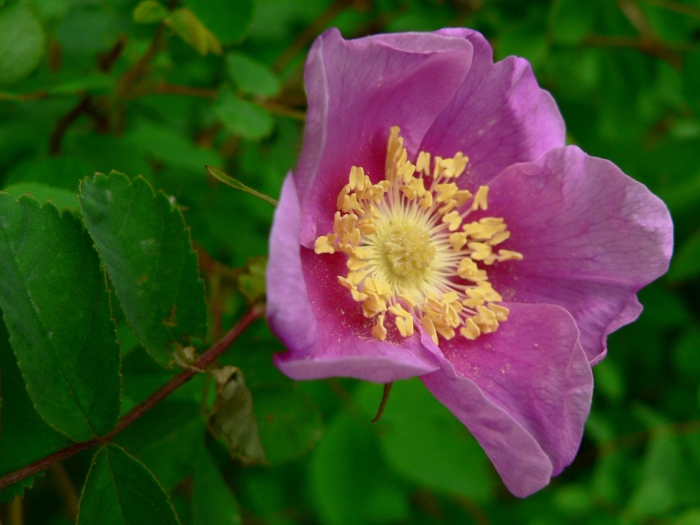Nootka Rose
(Rosa nutkana)
Nootka Rose (Rosa nutkana)
/
/

Walter Siegmund
CC BY 2.5
Image By:
Walter Siegmund
Recorded By:
Copyright:
CC BY 2.5
Copyright Notice:
Photo by: Walter Siegmund | License Type: CC BY 2.5 | License URL: https://creativecommons.org/licenses/by/2.5 | Uploader: Wsiegmund | Publisher: Wikimedia Commons | Title: Rosa_nutkana_07513.JPG | Notes: Photo of ''[[Zexmenia hispida]]'' [[Springs Preserve]] garden in [[Las Vegas, Nevada]], taken June 2005 by [[User:Stan Shebs]] {{GFDL-self}} |





































































Estimated Native Range
Summary
Rosa nutkana, commonly known as Nootka Rose, is a deciduous subshrub native to moist habitats in the Pacific Northwest, including stream banks, moist forest clearings, and wet meadows in the Northwestern USA and Canada. It typically grows up to 3 meters tall, often forming dense thickets. The plant features pinnate leaves with 5 to 7 leaflets and straight or curved thorns. The 5–8 cm (2–3 in) flowers are usually solitary or in small clusters of 2 or 3, blooming in early summer. They are pink to deep rose in color and can have a pleasantly strong fragrance, attracting a variety of pollinators. The fruits, or hips, are red to orange, spherical, and somewhat bitter but edible after bletting, which softens them and reduces bitterness. Only the rind should be consumed as the seeds can be irritating.
Nootka Rose is valued for its wildlife-friendly attributes, particularly its ability to provide food and habitat for birds and beneficial insects. It is used in wetland mitigation buffers, native plant landscaping, and as a natural barrier due to its thorny stems. This rose prefers full sun but can tolerate partial shade and requires high amounts of water, thriving in soils with medium to slow drainage. It is relatively low maintenance but can be susceptible to common rose diseases such as powdery mildew and rust. Gardeners may also use it for its ornamental qualities, including its showy flowers and attractive hips, which persist into winter.CC BY-SA 4.0
Nootka Rose is valued for its wildlife-friendly attributes, particularly its ability to provide food and habitat for birds and beneficial insects. It is used in wetland mitigation buffers, native plant landscaping, and as a natural barrier due to its thorny stems. This rose prefers full sun but can tolerate partial shade and requires high amounts of water, thriving in soils with medium to slow drainage. It is relatively low maintenance but can be susceptible to common rose diseases such as powdery mildew and rust. Gardeners may also use it for its ornamental qualities, including its showy flowers and attractive hips, which persist into winter.CC BY-SA 4.0
Plant Description
- Plant Type: Shrub
- Height: 5-6 feet
- Width: 3-4 feet
- Growth Rate: Rapid
- Flower Color: Pink
- Flowering Season: Spring
- Leaf Retention: Deciduous
Growth Requirements
- Sun: Full Sun, Part Shade
- Water: Medium
- Drainage: Medium, Slow
Common Uses
Bee Garden, Bird Garden, Butterfly Garden, Edible*Disclaimer: Easyscape's listed plant edibility is for informational use. Always verify the safety and proper identification of any plant before consumption., Fire Resistant, Fragrant, Rock Garden, Showy Flowers
Natural Habitat
Moist habitats in the Pacific Northwest, including stream banks, moist forest clearings, and wet meadows
Other Names
Common Names: Bristly Rose, Wild Rose, Nutka Rose, Rosier De Nootka, Nutkaros
Scientific Names: , Rosa nutkana, Rosa caryocarpa, Rosa lyalliana, Rosa manca, Rosa pandorana,
GBIF Accepted Name: Rosa nutkana C.Presl